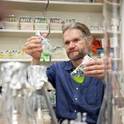
- Nucleosides,
- RNA -- Metabolism,
- Archaebacteria -- Molecular aspects,
- Transfer RNA -- Stability
Archaeosine (G+) is a structurally complex modified nucleoside found quasi-universally in the tRNA of Archaea and located at position 15 in the dihydrouridine loop, a site not modified in any tRNA outside of the Archaea. G+ is characterized by an unusual 7-deazaguanosine core structure with a formamidine group at the 7-position. The location of G+ at position 15, coupled with its novel molecular structure, led to a hypothesis that G+ stabilizes tRNA tertiary structure through several distinct mechanisms. To test whether G+ contributes to tRNA stability and define the biological role of G+, we investigated the consequences of introducing targeted mutations that disrupt the biosynthesis of G+ into the genome of the hyperthermophilic archaeon Thermococcus kodakarensis and the mesophilic archaeon Methanosarcina mazei, resulting in modification of the tRNA with the G+ precursor 7-cyano-7-deazaguansine (preQ0) (deletion of arcS) or no modification at position 15 (deletion of tgtA). Assays of tRNA stability from in vitro prepared and enzymatically modified tRNA transcripts, as well as tRNA isolated from the T. kodakarensis mutant strains, demonstrate that G+ at position 15 imparts stability to tRNAs that varies on the overall modification state of the tRNA and the concentration of magnesium chloride, and that when absent results in profound deficiencies in the thermophily of T. kodakarensis
Copyright © 2020 American Society for Microbiology.

This is the author’s version of a work that was accepted for publication in Journal of Bacteriology. Changes resulting from the publishing process, such as peer review, editing, corrections, structural formatting, and other quality control mechanisms may not be reflected in this document. Changes may have been made to this work since it was submitted for publication. A definitive version was subsequently published in Journal of Bacteriology, 202(8).